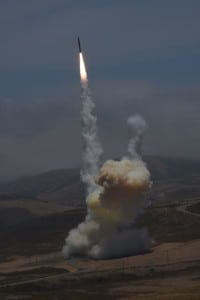The head of the Missile Defense Agency (MDA) argued service life extension program (SLEP) work on current Ground Based Interceptors (GBIs) in the Ground-based Midcourse Defense (GMD) system will help bridge the gap until the newer Next Generation Interceptors (NGIs) are ready to be fielded later this decade.
Speaking during the McAleese FY 20222 Defense Programs Conference on May 12, MDA Director Vice Adm. Jon Hill said he sees NGIs as the next block upgrade for the GMD system to help defend against future threats, particularly increasing North Korean intercontinental ballistic missile (ICBM) capabilities.

While Hill welcomes the two awards in the technical development phase for NGI, “what’s really been great over the last couple of years has been support from the department, support from Congress to do something called service life extension” on the GMD system.
In March, MDA awarded teams led by Lockheed Martin [LMT] and Northrop Grumman [NOC] for initial technology development and risk reduction contracts of the NGI. Both companies won contracts that, if all options are exercised, could reach nearly $4 billion each (Defense Daily, March 23).
“Its not just about the GBIs, but it’s also about the weapon system and its support…but what’s great about it is we’re now taking the oldest round, the oldest GBIs…and they’ve never been de-emplaced [since installation in 2004],” he continued.
Hill said under the SLEP, MDA is now removing the oldest GBIs from their silos, assessing the state of their propulsion, changing out one-shot devices, updating processes and updating the threat library.
“So what that allows those older missiles to do now, and we’re actually changing out the boosters, is to now perform at the level of the newest ones. And so it’s, to me, that’s pretty exciting.”
Hill said this process is also harvesting data that has been in hardware in silos since around 2004 “and now we have a hardware-based assessment for the stockpile reliability program and those in the weapons world know how important it is to have real data as opposed to analysis.”
He argued this now will raise the reliability of the overall GBI fleet “to kind of bridge that gap between when we’ll actually deploy the first NGI, but it’s also going to give us a strong sense of confidence to the warfighter that what he’s got today can take on the threat and we’ll end up with higher reliability.”
Hill said thanks to what MDA is learning from the SLEP, the agency can work with U.S. Northern Command “to reduce the shot doctrine or the salvo policy, as I like to call it, and to me that’s how we’re really bridging that gap.”
MDA plans to start testing the NGI in 2025-2026 and have interceptors being placed in silos at Fort Greely, Alaska by 2027-2028. It expects the cost of the planned 20 NGIs to reach over $11 billion.
Former MDA Director Lt. Gen. Samuel Greaves told a Senate panel in 2018 the agency was working to review GBIs in its stockpile reliability program (SRP), which included removing two GBIs from the GMD to inspect and test them to understand how the missiles age in the silos. Greaves said another GBI was being removed from its silo that year for the SRP and the agency extended the service life of GBI C1 and C2 boosters (Defense Daily, March 23, 2018).
The current 44 GBIs are divided into Block 1 with the CE-1 kill vehicle and C1 booster, Block 2A with the CE-II kill vehicle and C1 booster, and Block 2B with the CE-II Block 1 and C2 booster.